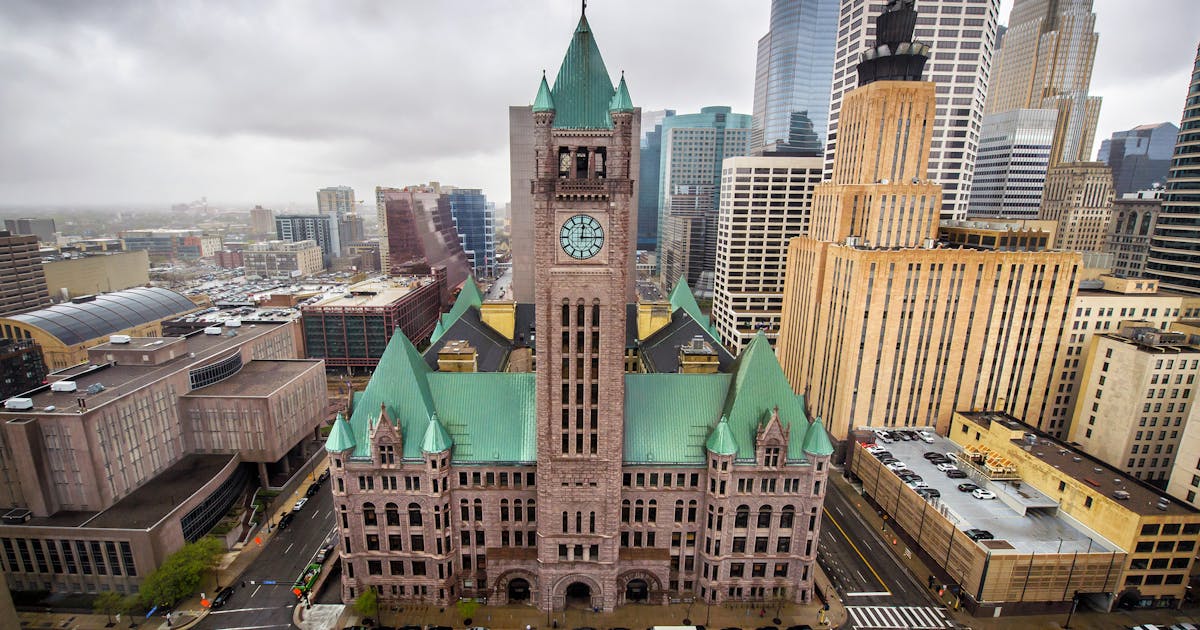Star Tribune
Minneapolis City Council to vote on whether to approve police oversight commission nominees

The Minneapolis City Council is scheduled to vote Thursday on whether to approve the new police oversight commission, with 15 proposed members representing a range of professional experience — but not all races.
The nominees include eight white members and seven people of color, five of whom are Black. One member is Black and Native American, and another is half white and half Native American. There are no Hispanic or Asian representatives on the committee, despite Hispanics making up nearly 10% of the city’s population and Asians nearly 6%.
The commission’s composition follows a major legal settlement with the state Department of Human Rights, approved by the city council in March, focused on racial discrimination involving police. Among many provisions, it required the city to create a police oversight commission and “to appoint a diverse group of community members that represent a cross-section of the Minneapolis community” including people with “different abilities” and “Black, Indigenous, and other individuals of color.”
The nominees seem skewed toward a professional class. It includes five with law degrees, with at least 11 of the 15 members holding college or university degrees. Among people of color, only one is a man.
The nominees were drawn from a pool of more than 160 applicants. Each of the city’s 13 council members nominated one commissioner and two were nominated by Mayor Jacob Frey. The council’s Public Health and Safety Committee approved the nominees last week.
The Star Tribune determined the racial composition of the commission by contacting nominees, council members and staff. The city clerk’s office declined to release the data, citing state privacy laws.
Commission members will sit on rotating panels made up of three members and two police officers to consider complaints against police. They’ll review investigative reports from the police internal affairs unit or city civil rights department, then vote on whether a complaint has merit. The police chief will decide then whether an officer should be disciplined, and if so, what it would be. The commissioners will meet at least four times a year to consider policy recommendations to the chief.
Based on interviews and their applications, here’s a snapshot of the nominees:
Ward 1: Josh Loar, white, senior consultant, for a company that designs performing arts venues. On the faculty of a university, he investigated a police response to a controversial rally on campus “I am very invested in community and ensuring that the police force is working with the community and not in opposition to it.”
Ward 2: Mara Schanfield, white, an educator, researcher, consultant, has training in psychology included a graduate degree in prevention science and practice coupled with a school counselor license.
Ward 3: Paul Olsen, white. Former legal counsel to the Seattle police department and assisted drafting a police accountability ordinance and served as co-counsel for Seattle in a federal consent decree on police issues.
Ward 4: Melissa Newman, Black, an insurance underwriter, who once worked in the record intake a juvenile probation office.
Ward 5: Jennifer Clement, white, a former school teacher in north Minneapolis, is now executive director of an organization that takes care of people with physical and mental health disabilities in their own home.
Ward 6: AJ Awed, Black, East African, executive director of Cedar Riverside Community Council. Awed said he saw a “total breakdown of trust between the city’s population and the police department” when he ran unsuccessfully for mayor in 2021 and wants “to inject some trust in the system.”
Ward 7: Mary Dedeaux-Swinton, Black, a community volunteer. “I’m a logical person and can objectively look at things and apply rules as they are,” she said. She served on the previous oversight board,
Ward 8: Fartun Weli, Somali-American and, CEO of Isuroon, a nonprofit serving Somali women and girls. “I am dedicated to fostering positive change between our community and the police, with a focus on increased accountability for law enforcement actions, particularly concerning people of color and the Somali community.”
Ward 9: Stacey Gurian-Sherman: white, managing partner of an organization that works on growing job skills, mentoring, conflict resolution and youth programming. “The disciplinary system with the Minneapolis Police Department has been abysmal,’ she said in an interview. “The system seems to be arbitrary, favoring some officers and discriminating against others.”
Ward 10: Alexis Pederson, half Native American, half white and a nanny. “I applied with the hope that this committee will be able to provide an additional level of accountability for individuals within MPD to uphold their oath of integrity, safety, as well as dignity and respect for human life.”
Ward 11: Philip Sturm, white, who has volunteered as a county special deputy and was on a police department/911 workgroup to find alternative responses to 911 calls not requiring an armed police officer. He ran unsuccessfully for Minneapolis mayor in 2021.
Ward 12: James Westphal, white, attorney, primarily criminal defense. He said there were no consequences for the Metro Gang Strike Force, a police unit shut down in 2009 for misconduct. “There has got to be accountability, but it needs to be a fair process.”
Ward 13: Nichelle Williams-Johnson, Black and Native American. Learning connections manager at the Learning Disabilities Association of Minnesota. “The main reason I applied for the commission is because I want to bridge the gap between the community and policing.”
Frey appointments:
Louis Smith, white, attorney. He has served on past boards including president of Advocates for Human Rights. As a former deputy Hennepin County attorney he chaired a task force that made recommendations on racial composition of grand juries.
Latonya Reeves, Black, probation officer, vice chair of the Minneapolis Civil Rights Commission. “We know we need reform, but we know we need responsible reform and that the community is heard and I am someone who loves the community.”
Star Tribune
Lynx lose WNBA Finals Game 3 against New York Liberty: Social media reacts

The Lynx are in the hot seat.
The team lost Game 3 of the WNBA Finals series against the New York Liberty on Wednesday night 77-80, setting the stage for a decisive match at Target Center on Friday night. Fans in the arena reacted with resounding disappointment after Sabrina Ionescu sunk a three-pointer to break away from the tie game and dashed the Lynx’s chance at forcing overtime.
Before we get to the reactions, first things first: The Lynx set an attendance record, filling Target Center with 19,521 spectators for the first time in franchise history. That’s nearly 500 more than when Caitlin Clark was in town with the Indiana Fever earlier this year.
Despite leading by double digits for much of the game, the Lynx began the fourth quarter with a one-point lead over the Liberty and struggled to stay more than two or three points ahead throughout.
The Liberty took the lead with minutes to go in the fourth quarter and folks were practically despondent.
Of course, there were people who were in it solely for the spectacle. Nothing more.
The Lynx took a commanding lead early in the first quarter and ended the first half in winning position, setting a particularly jovial mood among the fanbase to start the game.
Inside Target Center, arena announcers spent a few minutes before the game harassing Lynx fans — and Liberty fans — who had not yet donned the complementary T-shirts draped over every seat.
Star Tribune
Bong Bridge will get upgrades before Blatnik reroutes

DULUTH – The Minnesota and Wisconsin transportation departments will make upgrades to the Richard I. Bong Memorial Bridge in the summer of 2025, in preparation for the structure to become the premiere route between this city and Superior during reconstruction of the Blatnik Bridge.
Built in 1961, the Blatnik Bridge carries 33,000 vehicles per day along Interstate 535 and Hwy. 53. It will be entirely rebuilt, starting in 2027, with the help of $1 billion in federal funding announced earlier this year. MnDOT and WisDOT are splitting the remaining costs of the project, about $4 million each.
According to MnDOT, projects on the Bong Bridge will include spot painting, concrete surface repairs to the bridge abutments, concrete sealer on the deck, replacing rubber strip seal membranes on the main span’s joints and replacing light poles on the bridge and its points of entry. It’s expected to take two months, transportation officials said during a recent meeting at the Superior Public Library.
During this time there will be occasional lane closures, detours at the off-ramps, and for about three weeks the sidewalk path alongside the bridge will be closed.
The Bong Bridge, which crosses the St. Louis River, opened to traffic in 1985 and is the lesser-used of the two bridges. Officials said they want to keep maintenance to a minimum on the span during the Blatnik project, which is expected to take four years.
Star Tribune
Red Wing Pickleball fans celebrate opening permanent courts

Red Wing will celebrate the grand opening of its first permanent set of pickleball courts next week with an “inaugural play” on the six courts at Colvill Park on the banks of the Mississippi, between a couple of marinas and next to the aquatic center.
Among the first to get to play on the new courts will be David Anderson, who brought pickleball to the local YMCA in 2008, before the nationwide pickleball craze took hold, and Denny Yecke, at 92 the oldest pickleball player in Red Wing.
The inaugural play begins at 11 a.m. Tuesday, with a rain date of the next day. Afterward will be food and celebration at the Colvill Park Courtyard building.
Tim Sletten, the city’s former police chief, discovered America’s fastest-growing sport a decade ago after he retired. With fellow members of the Red Wing Pickleball Group, he’d play indoors at the local YMCA or outdoors at a local school, on courts made for other sports. But they didn’t have a permanent place, so they approached the city about building one.
When a city feasibility study came up with a high cost, about $350,000, Sletten’s group got together to raise money.
The courts are even opening ahead of schedule, originally set for 2025.





GIPHY App Key not set. Please check settings